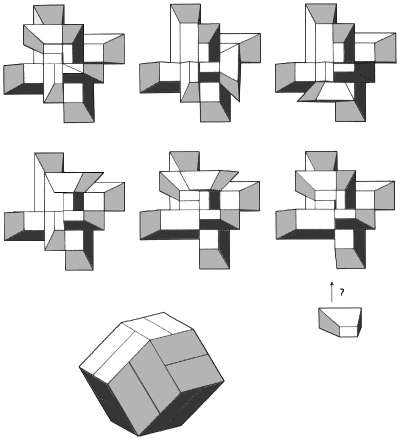
Some of the material for this book came from the far corners of the world and beyond. The following incredible story was provided by a correspondent in Calcutta named Paul F. Gahn. I cannot vouch for its authenticity and present it here just as it came to me.
Paul is a puzzle maker and puzzle historian of sorts. He was in his workshop late one evening when there was a knock on the door and a very attractive young woman entered. She held a small bundle wrapped in a scarf and said she had something to show him. As she unwrapped the bundle, six wooden puzzle pieces tumbled out onto the workbench. Paul immediately became quite interested. She showed him that all six pieces were supposed to be made of eight blocks glued together, but one of them had a block missing. She asked him if he would repair the broken piece and then assemble the puzzle. He said he would be glad to if she would tell him more about the puzzle, such as its origin. She said she would, and this was her amazing story:
The puzzle first appears in the hands of a prosperous Afghan merchant in the early 19th century, and where he got it no one knows. The merchant had two daughters. The older daughter fell in love with a British soldier, and soon they announced they wished to be married. The father was not too keen on this, and he decided to put the young man's wits to a test. He gave the soldier the puzzle in pieces and said that as soon as it was assembled the wedding could be arranged. The young man worked feverishly on it, with the girl secretly helping, and finally after two weeks proudly presented it to the father assembled. Plans were made for a wedding the following week. Just when everything seemed fine, the younger daughter brought the puzzle to her father and remarked that she could hear something rattling inside. Taking it apart, they found one block broken off and loose inside, and careful inspection revealed that it had been done in order to create a second solution. The enraged father summoned the two lovers and confronted them with the evidence, which they vigorously denied having any knowledge of.
At this point in the story, Paul interrupted and asked if it were not possible that the younger sister may have been jealous and had done this out of spite. She replied that, as a matter of fact, that was the case. The father was not sure, but he had his suspicions. After he had cooled down, he said that the wedding could take place, but only after the puzzle was repaired and put back together correctly.
The poor lovers worked desperately on the puzzle for weeks, as they were quite anxious to be married soon. But alas, they simply could not solve it. Finally, one fateful day the distraught young woman took her own life by fire. The soldier vanished from the scene and was never heard from again. The accursed puzzle also disappeared.
Paul had excitedly been taking notes and making sketches while the woman was talking. He was beginning to wonder if this could be the fabled "lost puzzle" supposed to have been invented by the legendary Chinese mathematician Mee-Sing Won of the Ming dynasty!
Again the woman asked Paul if he could help her, but now with tears in her eyes. He said of course he would, but first he would have to try to match the wood for the missing block. She said that would not be necessary, and reaching down into her bosom drew forth the missing block and handed it to him. Already rather shaken, he was even more startled to find the block too hot to handle! The woman said she could not stay any longer. Paul asked her how he could contact her when the job was done. She said that would not be necessary - she just wanted it fixed. Paul looked at her quizzically. "You see," she said, "the wedding cannot take place until it is repaired."
Suddenly Paul thought he smelled smoke, which is enough to rouse any woodworker. Glancing around, he found that the woman had vanished and so had the puzzle pieces. All that remained was his sketch. A strange story indeed!
From the illustration (Fig. 174), it can be seen that the puzzle consists of six dissimilar non-symmetrical pieces of eight blocks each. It is a straightforward two-tiered dissection of the rhombic dodecahedron. The inner 24 blocks are skewed rhomboid pyramids that are incidentally truncated, making the center hollow. The outer 24 blocks are also skewed rhomboid pyramids that are necessarily truncated to contain the inner and are arranged symmetrically.
Fig. 174
The object of the puzzle is to discover both solutions with the loose block not attached. It can be left loose or held temporarily in place using tape. The two solutions could be distinguished from each other by markings on the outside faces such as color symmetry.
By the way, which of the two sisters do you suppose she was?